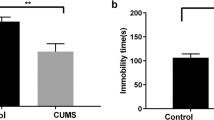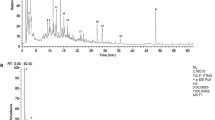Abstract
Objective
To determine the changes in the levels of endogenous metabolites in rats with chronic immobilization stress (CIS) taking Xiaoyao Powder (逍遥散, XYP) and its modified prescription version, which lacks the volatile oils extracted from Herba Menthae.
Methods
Twenty-four experimental male SD rats were randomly divided into 4 groups of 6 rats each: control, model, XYP-1 (containing volatile oils from Herba Menthae), and XYP-2 (lacking volatile oils). All rats except control group rats were subjected to CIS 3 h per day for 21 consecutive days. Groups XYP-1 and XYP-2 were given the extracted XYS with or without volatile oils (3.854 g/kg; suspended in distilled water) via gavage 1 h before CIS each day for 21 days. Rats were anesthetized using intraperitoneal injection of pentobarbital sodium (40 mg/kg) on the 22nd day. Observations were made using a Varian INOVA 600 MHz NMR spectrometer at 27 °C. Carr-Purcell-Meiboom-Gill (CPMG) and longitudinal eddy-delay (LED) were applied, resulting in spectra showing only the signals from micro- and macro-metabolites.
Results
Compared to controls, rats subjected to CIS showed increased levels of plasma metabolites, such as acetic acid, choline, N-glycoprotein (NAC), saturated fatty acid, and blood sugars. Levels of low-density lipoprotein (LDL), very low-density lipoprotein (VLDL), and unsaturated fatty acids were decreased. The biochemical effects of XYS were characterized by elevated levels of VLDL, LDL, threonine, methionine, and glutamic acid in plasma.
Conclusion
Some common and characteristic metabolites on the anti-CIS of XYP and its modified prescription were obtained. The metabolomics technology is a valuable tool and may be used to identify the specific metabolites and potential biomarkers of therapeutic effect of Chinese medicinal prescriptions.
Similar content being viewed by others
References
Mazure CM. Does stress cause psychiatric illness? In: Spiegel D, ed. Progress in psychiatry. Washington D. C.: American Psychiatric Press; 1995:270–298.
Ricart-Jané DV, RodrÍguez-Sureda A, Benavides J, Peinado-Onsurb MD, López-Tejero, Llobera M. Immobilication stress alters intermediate metabolism and circulating lipoproteins in the rat. Metabolism 2002;51:925–931.
Vanitallie TB. Stress: a risk factor for serious illness. Metabolism 2002;51(6 Suppl. 1):40–45.
Brinkley DN, Rolland Y. Possible connections between stress, diabetes, obesity, hypertension and altered lipoprotein metabolism that may result in atherosclerosis. Clin Sci 1989;77:453–461.
Tang YT, Chen JX. Regulative effects of three TCM formulas on hypothalamus-pituitary-adrenal axis in the rats with chronic restrained stress. J Beijing Univ Tradit Chin Med (Chin) 2002;25:23–26.
Chen JX, Li W, Zhao X, Yang JX, Xu HY, Wang ZF, et al. Changes of mRNA expression of enkephalin and prodynorphin in hippocampus of rats with chronic immobilization stress. World J Gastroenterol 2004;10:2547–2549.
Chen JX, Li W, Zhao X, Yang JX. Effects of the Chinese traditional prescription Xiaoyaosan decoction on chronic immobilization stress-induced changes in behavior and brain BDNF, TrkB, and NT-3 in rats. Cell Mol Neurobiol 2008;5:745–755.
Chen JX, Tang YT, Yang JX. Changes of glucocorticoid receptor and levels of CRF mRNA, POMC mRNA in brain of chronic immobilization stress rats. Cell Mol Neurobiol 2008;28:237–234.
Teague CR, Dhabhar FS, Barton RH, Beckwith-Hall B, Powell J, Cobain M, et al. Metabonomic studies on the physiological effects of acute and chronic psychological stress in Sprague-Dawley rats. J Proteome Res 2007;6:2080–2093.
Nicholson JK, Lindon JC, Holmes E. “Metabonomics”: understanding the metabolic responses of living systems to pathophysiological stimuli via multivariate statistical analysis of biological NMR spectroscopic data. Xenobiotica 1999;29:1181–1189.
Nicholson JK, Wilson LD. High resolution nuclear magnetic resonance spectroscopy of biological samples as an aid to drug development. Prog Drug Res 1987;31:427–479.
Nicholson JK, Wilson ID. Opinion: understanding “global” systems biology: metabonomics and the continuum of metabolism. Nat Rev Drug Discov 2003;2:668–676.
Wang Y, Holmes E, Tang H, Lindon JC, Sprenger N, Turini ME, et al. Experimental metabonomic model of dietary variation and stress interactions. J Proteome Res 2006;5:1535–1542.
Waters NJ, Waterfield CJ, Farrant RD, Holmes E, Nicholson JK. Metabonomic deconvolution of embedded toxicity: application to thioacetamide hepato- and nephrotoxicity. Chem Res Toxicol 2005;4:639–654.
Lindon JC, Nicholson JK, Holmes E, Everett JR. Metabonomics: metabolic processes studied by NMR spectroscopy of biofluids. Concepts Magn Reson 2000;12:289–320.
Luo HG, Chen JX, Yue GX, Ding J, Yan XZ. Metabonomic study on the regulatory effect of Xiaoyao Powder on chronic immobilization stressed rats. Chin J Integr Tradit West Med (Chin) 2008;12:1112–1116.
Yue GX, Wang ZF, Zhang QL, Chen JX, Zhao X, Yue LF, et al. Changes on AMPA receptors and levels of related proteins’ mRNA in brain of chronic immobilization stress rats and regulative effects on them. J Chin Integr Med (Chin) 2007;12:1110–1115.
Shi HL, Cheng YY, Li ST, Wang DL, Yu ZJ, Geng ZH, et al. Effects of chronic restraint stress on intestinal barrier function of rats. Chin J Behav Med Sci (Chin) 2003;3:251–253.
Lv ZP. Changes of lipid peroxidation in rats of stagnation of Liver-qi and effect of Xiaoyao Power. J Shandong Coll Tradit Chin Med (Chin) 1995;3:199.
Lu ZP, Liu CC. Changes of TXA2, PGI2 in rats of stagnation of Liver-qi and liver microcirculatory and effect of Xiaoyao Power. Chin J Microcircul (Chin) 2000;3:160.
Author information
Authors and Affiliations
Corresponding author
Additional information
Supported by the National Natural Science Foundation of China (No. 30672578), China National Funds for Distinguished Young Scientists (No. 30825046), and Program for Innovative Research Team in Beijing University of Chinese Medicine (No. 2011CXTD-07)
Rights and permissions
About this article
Cite this article
Luo, Hg., Chen, Jx., Zhang, Q. et al. Comparative study on effects of Xiaoyao Powder (逍遥散) and its modified prescription on plasma metabolomics of rats with chronic immobilization stress. Chin. J. Integr. Med. 19, 610–615 (2013). https://doi.org/10.1007/s11655-012-1092-0
Received:
Published:
Issue Date:
DOI: https://doi.org/10.1007/s11655-012-1092-0




